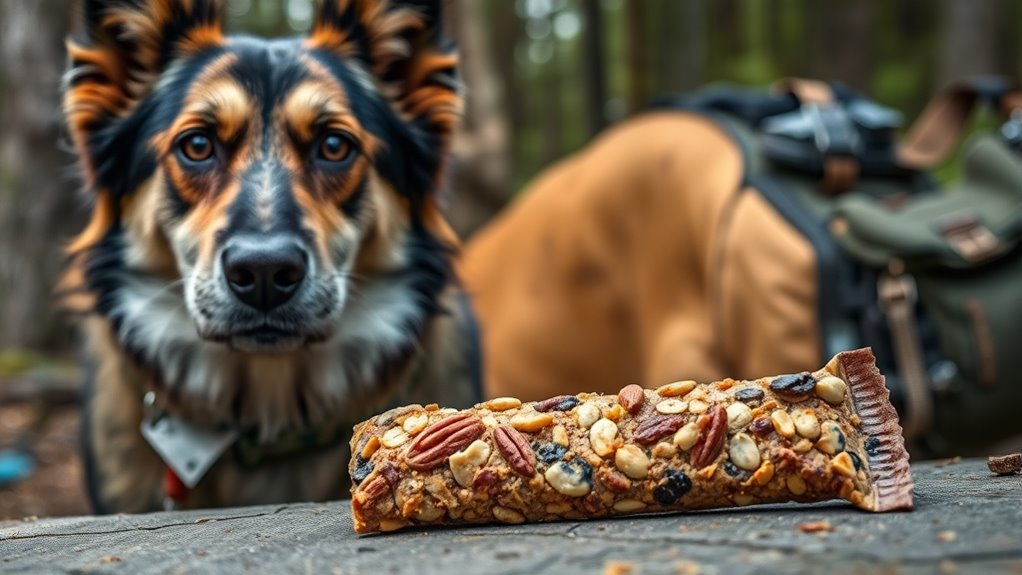Energy bars for working dogs are designed to provide quick, sustained nutrition during demanding tasks and long shifts. They support energy levels, muscle recovery, and stamina by offering a balanced mix of proteins, healthy fats, and complex carbs. Choosing the right bar involves checking nutrition labels and matching formulations to your dog’s workload. Proper use helps prevent fatigue and boosts resilience. Keep exploring to discover how to select and use energy bars effectively for your working dog’s needs.
Key Takeaways
- Choose energy bars with high-quality proteins, healthy fats, and complex carbs tailored to your working dog’s activity level.
- Use as a supplement during demanding tasks, not a replacement for balanced meals.
- Check nutritional labels for appropriate calorie content to prevent overfeeding or fatigue.
- Offer small portions before long activities and ensure access to fresh water for hydration.
- Select products designed specifically for working dogs to support stamina, recovery, and overall performance.

When working dogs perform demanding tasks, maintaining their energy levels is essential for peak performance. Energy bars designed for these dogs are an excellent way to provide quick, sustained nourishment, especially during long shifts or intense activity. To guarantee you’re giving your working dog the best, it’s important to understand the nutritional content of these bars and follow appropriate feeding guidelines. The nutritional content determines how well the bar supports your dog’s energy needs, muscle recovery, and overall stamina. Look for energy bars that contain high-quality proteins, healthy fats, and complex carbohydrates. Proteins are indispensable for muscle repair and growth, especially after strenuous work, while healthy fats offer a dense source of energy that can sustain your dog over extended periods. Complex carbs, like oats or sweet potatoes, provide slow-releasing energy, helping to keep your working dog alert and active without sudden sugar crashes.
When choosing an energy bar, always check the nutritional content label. You want a balance that matches your dog’s workload and size. For example, a heavy-duty search and rescue dog might require a different formulation than a service dog on lighter duty. It’s also important to consider the caloric content; too many calories can lead to unwanted weight gain, while too few might leave your dog fatigued. The feeding guidelines accompany these bars and provide essential information on serving sizes based on your dog’s weight and activity level. Follow these guidelines carefully to avoid overfeeding or underfeeding, both of which can impair performance and health. Incorporating proper nutrition into your dog’s diet can enhance their resilience and recovery after intense activity.
Incorporate these energy bars into your dog’s diet thoughtfully. They shouldn’t replace regular meals but supplement them during periods of high energy demand. For example, give your dog a small portion before a long run or during a break in a demanding task. Always guarantee fresh water is available, as hydration complements nutritional support. Keep in mind that each dog is unique, so monitor how your dog responds to energy bars and adjust the quantity as needed. Consult with a veterinarian if you’re unsure about the best product or feeding plan for your working dog. Proper nutrition isn’t just about quick energy; it’s about supporting your dog’s overall health, endurance, and recovery, helping them perform at their best every time they’re called into action.
Frequently Asked Questions
Can Energy Bars Replace Regular Dog Food During Training?
Energy bars can’t replace regular dog food during training because they don’t meet your dog’s complete dietary needs. For proper training nutrition, you should guarantee your dog gets balanced meals that include all essential nutrients. While energy bars might provide quick energy, they lack the full spectrum of vitamins, minerals, and proteins necessary for long-term health. Always prioritize a balanced diet tailored to your dog’s specific dietary needs.
Are Energy Bars Safe for All Breeds of Working Dogs?
You might wonder if energy bars are safe for all breeds of working dogs. While they suit many breeds, breed suitability varies, and some dogs might have sensitivities. Research shows that ingredient safety is vital, as not all energy bars are formulated for canine health. Always check labels and consult your vet before introducing energy bars to your dog’s diet, especially for breeds with specific dietary needs or allergies.
How Often Should Working Dogs Consume Energy Bars?
You should give your working dog energy bars based on their training schedules and nutritional requirements. Generally, offer them as a supplement during intense or prolonged activities, typically every 2-3 hours. Observe their energy levels and adapt accordingly. Always consult your vet to ensure the energy bars fit your dog’s specific needs, and avoid overfeeding to prevent weight gain or digestive issues.
Do Energy Bars Contain Artificial Ingredients or Preservatives?
Energy bars for working dogs may contain artificial ingredients or preservatives, so it’s vital to verify labels carefully. Some bars include artificial flavors, colors, or preservatives to prolong shelf life, but others use natural ingredients. Always opt for high-quality options with minimal artificial additives to ensure your dog’s health and performance. Reading ingredient lists helps you choose products that prioritize natural, safe ingredients over artificial ones.
What Are the Signs of an Energy Bar Allergy in Dogs?
If your dog shows signs of an energy bar allergy, you might notice food intolerance symptoms like vomiting, diarrhea, or excessive licking. Skin irritation, such as redness, itching, or swelling, is also usual. Keep an eye out for these reactions after your dog consumes the bar, and if they occur, stop feeding it immediately. Consult your vet for proper diagnosis and guidance to make certain your dog’s health and safety.
Conclusion
Choosing the right energy bars for your working dog can make all the difference in their stamina and performance. When you fuel them properly, you’re not just helping them survive the day—you’re empowering a superdog capable of feats that seem to defy nature itself. Remember, a well-nourished dog isn’t just an asset; they’re your ultimate partner in tackling the impossible. So, give your loyal friend the energy boost they deserve and watch them conquer every challenge ahead.









